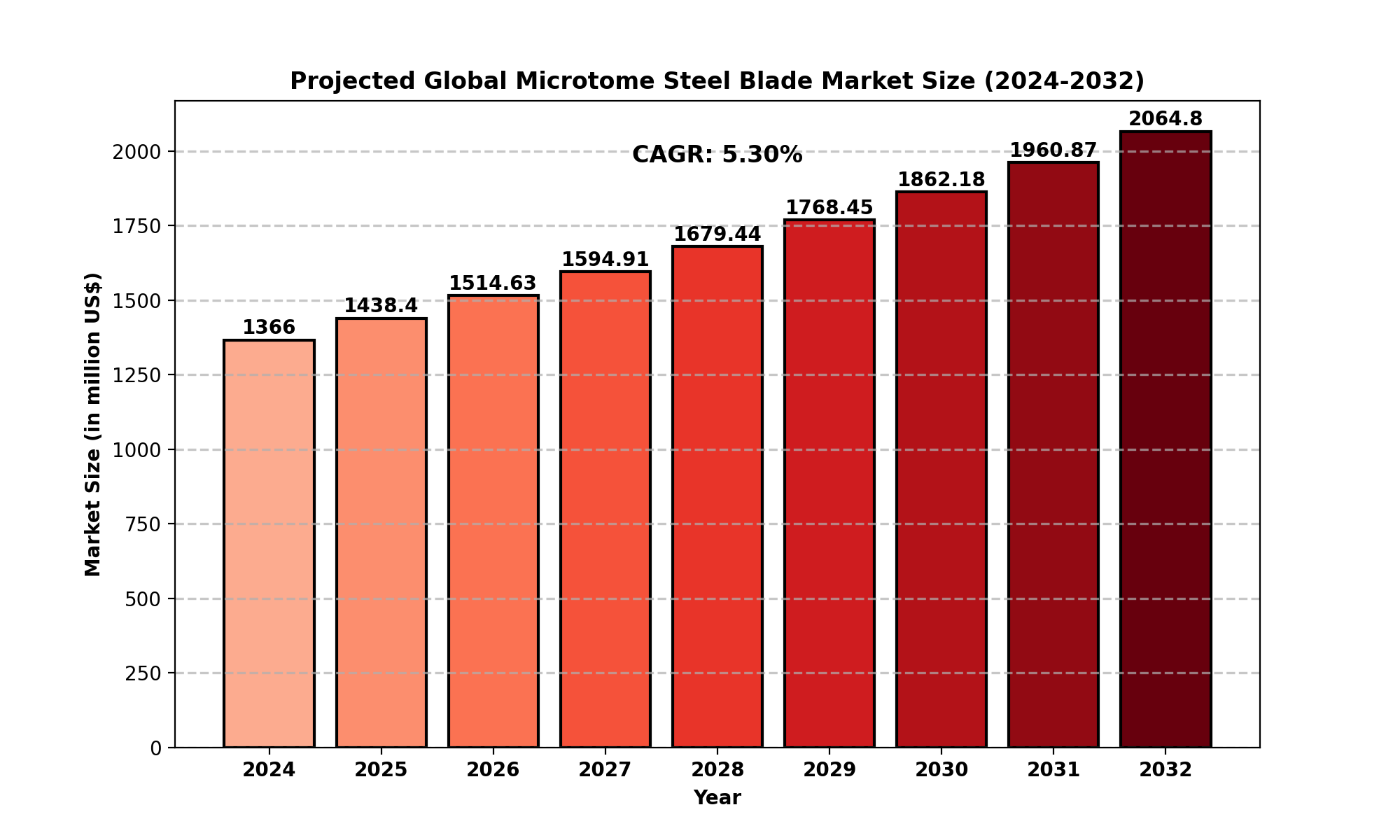TOP CATEGORY: Chemicals & Materials | Life Sciences | Banking & Finance | ICT Media

Download Report PDF Instantly
Report overview
The Microtome Steel Blade market refers to the segment of the medical device industry that focuses on manufacturing and distributing high-precision blades used for tissue slicing in laboratories and medical settings. These blades are typically made from steel, offering durability, sharpness, and a smooth cutting surface. Microtome blades are primarily used in the preparation of thin tissue slices for microscopy, research, and diagnostics, making them a vital tool in histology, pathology, and clinical laboratories. The blades are designed to slice paraffin-embedded tissues, ensuring precise cuts for examination under microscopes.
The global Microtome Steel Blade market was valued at USD 1,366 million in 2024 and is projected to reach USD 2,064.8 million by 2032, growing at a CAGR of 5.30% during the forecast period.
This growth is primarily driven by increasing demand from research, clinical, and diagnostic laboratories, as well as advancements in medical technology. Rising awareness about early disease detection and the growing prevalence of diseases like cancer and neurological disorders have further fueled the demand for precise tissue slicing tools. The growing emphasis on precision medicine and personalized healthcare will continue to support the market’s expansion.

Drivers
Several factors contribute to the growth of the Microtome Steel Blade market:
Increased Research and Diagnostic Applications: As the demand for accurate diagnostics and early disease detection increases, the need for microtome blades in laboratories becomes more prominent. Research activities in histopathology and molecular biology heavily rely on the precise cutting capabilities of these blades.
Rising Prevalence of Chronic Diseases: The global rise in chronic conditions such as cancer, Alzheimer's, and diabetes demands advanced diagnostic techniques. Microtome blades play a critical role in preparing tissue samples for these tests.
Technological Advancements: Innovations in microtome blade manufacturing processes, including the use of specialized coatings and materials for enhanced durability, have improved the overall performance and lifespan of the blades. These advancements contribute to their growing adoption.
Restraints
While the market shows strong growth, there are several challenges affecting its expansion:
High Initial Cost: Microtome blades, especially those with specialized coatings or high precision, can be expensive. This is a barrier for smaller labs or those in emerging markets with limited budgets.
Limited Product Life Cycle: Microtome blades have a finite lifespan due to wear and tear from cutting. This necessitates regular replacements, contributing to ongoing costs for laboratories, which can be a deterrent for some users.
Alternatives: The development of alternative technologies for tissue sectioning, such as cryostat devices, might reduce the dependency on microtome blades in certain applications.
Opportunities
Emerging Markets: The increasing number of diagnostic laboratories and research facilities in regions like Asia-Pacific, Africa, and Latin America presents significant opportunities for market growth.
Customization: Tailored solutions for specific applications, such as ultra-thin or high-precision blades, offer opportunities for product differentiation and market penetration.
Growing Importance of Personalized Medicine: As personalized medicine continues to gain traction, microtome blades are crucial in the preparation of tissue samples for tailored treatment planning.
Challenges
Regulatory Compliance: The medical device industry is highly regulated. Manufacturers must comply with stringent regulations in various regions, which can increase costs and extend time to market.
Competition: The market is highly competitive, with many players vying for market share. Smaller manufacturers may struggle to compete with established brands that dominate the market.
The global Microtome Steel Blade market shows distinct growth patterns across different regions, driven by varying levels of demand, technological adoption, and healthcare investments.
North America
North America dominates the Microtome Steel Blade market, accounting for a significant portion of global demand. The United States, in particular, has a well-established healthcare infrastructure, with numerous diagnostic and research laboratories requiring high-precision tissue slicing tools. In 2024, the North American market size was estimated at USD 389.01 million, growing at a CAGR of 4.54% during the forecast period (2025–2032). The region’s advanced healthcare systems, coupled with increasing research activities, fuel this growth.
Europe
Europe is another key player in the market, with strong demand in countries like Germany, the United Kingdom, and France. The rise in cancer research and diagnostics, combined with a focus on improving healthcare systems, drives the market. With increasing investments in medical technologies, the European market is expected to continue its steady growth throughout the forecast period.
Asia-Pacific
The Asia-Pacific region is expected to experience the highest growth in the Microtome Steel Blade market. This is attributed to rapid industrialization, growing healthcare investments, and an expanding base of research institutions in countries like China, India, and Japan. Rising healthcare awareness and the increasing prevalence of diseases are also expected to drive market growth in this region.
South America and MEA
The South American and Middle East and Africa regions are also expected to witness steady growth. However, these regions face challenges like budget constraints and limited access to advanced medical technologies, which may hinder market growth.
The Microtome Steel Blade market features a competitive landscape with several well-established players. Key companies include:
Leica Biosystems: A global leader in laboratory equipment, Leica is known for its precision microtome blades.
Epredia: Known for its high-quality microtome blades used in pathology and histology applications.
FEATHER: A Japanese manufacturer recognized for producing durable, high-precision blades for various scientific applications.
Sakura Finetek: A prominent supplier of tissue processing and microtome solutions, Sakura Finetek has a strong presence in the global market.
AccuTec Blades: Specializes in high-quality, durable blades for research and clinical applications.
These companies have adopted various strategies, including partnerships, mergers, and new product developments, to expand their market share and strengthen their competitive positioning.
This report provides a deep insight into the global Microtome Steel Blade market, covering all its essential aspects. This ranges from a macro overview of the market to micro details of the market size, competitive landscape, development trend, niche market, key market drivers, and challenges, SWOT analysis, value chain analysis, etc.
The analysis helps the reader shape the competition within the industries and strategies for the competitive environment to enhance the potential profit. Furthermore, it provides a simple framework for evaluating and assessing the position of the business organization. The report structure also focuses on the competitive landscape of the Global Microtome Steel Blade Market, introducing in detail the market share, market performance, product situation, operation situation, etc., of the main players. This helps readers in the industry identify the main competitors and deeply understand the competition pattern of the market.
In a word, this report is a must-read for industry players, investors, researchers, consultants, business strategists, and all those who have any kind of stake or are planning to foray into the Microtome Steel Blade market in any manner.
Research
Clinical
Others
Low Profile Blades
High Profile Blades
Others
Leica Biosystems
Epredia
FEATHER
Sakura Finetek
CL Sturkey
AccuTec Blades
Diapath
Trajan
Crescent Blades
General Data
StatLab
Avantik
North America (USA, Canada, Mexico)
Europe (Germany, UK, France, Russia, Italy, Rest of Europe)
Asia-Pacific (China, Japan, South Korea, India, Southeast Asia, Rest of Asia-Pacific)
South America (Brazil, Argentina, Columbia, Rest of South America)
The Middle East and Africa (Saudi Arabia, UAE, Egypt, Nigeria, South Africa, Rest of MEA)
What is the current market size of Microtome Steel Blades?
Which are the key companies operating in the Microtome Steel Blade market?
What are the key growth drivers in the Microtome Steel Blade market?
Which regions dominate the Microtome Steel Blade market?
What are the emerging trends in the Microtome Steel Blade market?